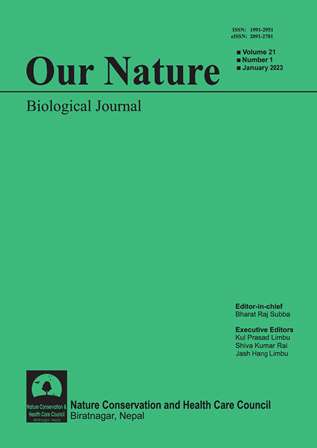Macro-fungi diversity in Thulo Ban Community Forest of Arjam, Myagdi District, Nepal
DOI:
https://doi.org/10.3126/on.v21i1.50766Keywords:
Cantharellus cibarius, forest ecosystem, Russulaceae, subtropical mixed forestAbstract
Macro-fungi produce large fructifications that are visible without the help of a microscope. They play an important role in the conservation of forest ecosystems and biodiversity. The current study deals with the diversity of macro-fungi in the subtropical mixed forest of Arjam, Myagdi District. The study was conducted from June to September 2020, at a height of 1250 to 1450 meters above sea level. In three transects, 10 m×10 m quadrat was used and a total of 18 plots were made. A total of 70 macrofungal taxa were collected. Among them, 56 were identified at the species level, and 14 were generic levels belonging to 26 different families and 12 orders. The highest species-containing family was Russulaceae, with 16 species, whereas the densest species was Mycena sp., comprising 11.8 percent and Cantharellus cibarius was the most frequent species, consisting of 44.44 percent.
Downloads
Downloads
Published
How to Cite
Issue
Section
License
Copyright (c) 2023 Shashi Shrestha, Sadikshya Thapa, Sanjay Kumar Jha

This work is licensed under a Creative Commons Attribution-NonCommercial 4.0 International License.
This license enables reusers to distribute, remix, adapt, and build upon the material in any medium or format for noncommercial purposes only, and only so long as attribution is given to the creator.




